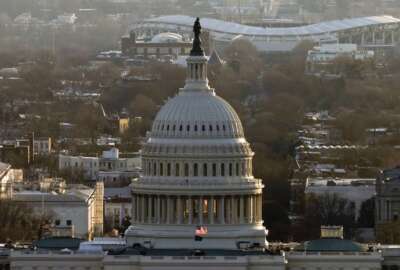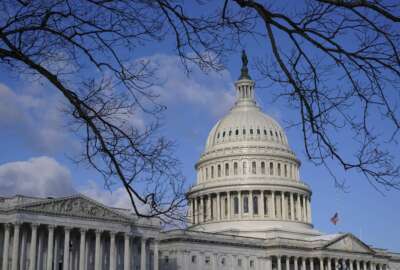OPM fast tracking draft regulations for phased retirement
Director John Berry said the agency's Innovation Lab is helping to take a different, more rapid approach to developing the proposed rule to implement the new...
wfedstaff | April 17, 2015 4:29 pm
Three times more federal employees are expected to retire as of Jan. 1 than at any other time during the year.
In January 2012, more than 21,000 federal employees decided to leave their jobs, according to the Office of Personnel Management statistics. As January rolls around once again, OPM officials expect another rush of retirements.
OPM Director John Berry is trying to blunt the impact of the flood of retirees by getting the proposed regulations for phase retirement out in early 2013. President Barack Obama in July signed the highway transportation bill into law, which included a provision giving federal employees the ability to opt for partial retirement and still be paid for working part-time.
Berry said the regulations are on a fast track.
“You know the long nature of the federal regulatory process, a 90-day public comment, and then another 90-day public comment and it goes on and on. Left to the normal approach, it would take quite a while to get it up and running,” he said after a recent speech before the Fairfax County (Va.) Chamber of Commerce. “We are trying to get it up and running because I’m keenly aware many make the decision to retire in January. I can’t have final regs in place by January, but wouldn’t it be great to issue by the end of the year draft regulations? Then people who are retiring will essentially know what the rules of the road will be. The process still may change, but they’ll have a pretty good idea of how it will work.” 
Developing the rule in the Innovation Lab
Still, OPM is using its Innovation Lab to change the way it writes regulations.
Berry said the OPM team working on the regulations is meeting with experts, such as those from the National Active and Retired Federal Employees (NARFE), to get the draft regulations out more quickly.
One option is OPM could issue an interim rule with a request for comments because of the importance of the program.
Berry said he’s not sure if using the interim status is possible.
“The lawyers try to keep you on the same process and same approach,” he said. “Right now, people are saying this is one that has to go through the regulatory process.”
OPM has been focusing on reducing the backlog of retirement applications all the while new ones come in. There was a spike in September as more than 11,000 workers retired, the second biggest month since January.
Berry said he’s not concerned that the regulations for phased retirement are coming too late.
“What’s driving the current numbers you are seeing in the trends is we can track pretty specifically, for example, right now most of that is being driven by the Postal Service,” Berry said. “They are running a specific buy-out to reduce their workforce. We knew that was coming, but we didn’t know what month. It’s starting to arrive now and that’s what’s happening with much of that number we are seeing. What we are not seeing is a new huge wave. I don’t see any evidence of that right now. But we watch it on a monthly basis.”
He said OPM continues to focus on reducing the retirement claims backlog. As of November, the number of claims waiting for OPM action was 31,704, down almost by 50 percent since January when the backlog stood at 61,108.
“We are staying ahead of the plan we published. Our folks are working hard and doing a great job,” he said. “By this time next year, I hope I’ll be talking to you about how it was fixed.”
Must tear down rigid rules
The option for a phased retirement is one way Congress and the administration are trying to make the federal workplace more flexible.
Rep. Gerry Connolly (D-Va.) said the most important thing the government can do for its current employees and to recruit new workers is ensure that flexibility. 
Connolly said the administration has made some progress such as getting rid of the requirement for applicants to detail knowledge, skills and abilities, but there are more opportunities too. He said, for example, agencies should use interns to recruit new employees similarly to the way the private sector does.
“We are trying to make sure we streamline that, make it more efficient, we standardize how we use it and we significantly increase the percentage of people who intern with federal agencies who come back and actually become federal employees,” he said. “That’s what it’s there for.”
Connolly also would support the idea of letting federal employees who decide to move the private sector keep their annual or sick leave in a “bank,” so when they return to the government they aren’t starting from scratch.
Berry said the idea of a leave bank is innovative and would increase employees’ flexibility and choices.
“Rather than having to cash out your leave, you could create an account and maintain the leave. You could also withdraw it if you needed it to buy a house or something,” Berry said. “I think it’s an interesting idea. We will look at the details of it, and it maybe one that we can recommend to OMB that we support and take to the president and see if we can move it along.”
More pressure for telework
Berry said he hasn’t brought this idea of a leave bank yet to the Office of Management and Budget.
Connolly said the proposal doesn’t have to come from the administration, but they may want to.
He said one of the areas he believes Congress still must address around the federal workforce is telework metrics.
Connolly said several agencies are doing well in meeting the Telework Enhancement Act, but others, especially in the national security community, are doing poorly.
“Maybe we need to set some metrics in statute that people have to move toward so we can accelerate the progress in telework,” he said. “That benefits the workforce. The workforce of the future expects that. It benefits productivity, morale and it benefits our environment, especially here in the National Capital Region.”
RELATED STORIES:
OPM breaks down the basics of phased retirement
OPM’s innovation lab spurs new way of problem solving
Federal retirement claims fall last month, but OPM predicts swell in January
Copyright © 2025 Federal News Network. All rights reserved. This website is not intended for users located within the European Economic Area.
Jason Miller is executive editor of Federal News Network and directs news coverage on the people, policy and programs of the federal government.
Follow @jmillerWFED






